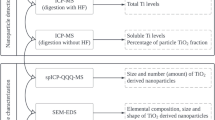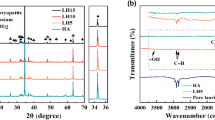Abstract
Diamond-like carbon (DLC) and titanium-doped DLC coatings were prepared by hybrid PECVD/direct current magnetron sputtering (DCMS). In this study, we show that the operating conditions of titanium-doped DLC coatings used for implants in surgical devices significantly modify their surface properties and consequently their interaction with cells. The coatings showed uniform distribution on the substrate and their biocompatibility was tested by way of rat calvaria osteoblasts. Doping DLC with Ti changed the roughness and wettability of the film interface. The autoclaving of the samples led to the surface oxidation and the formation of TiO2 on the top-most layers of Ti-doped DLC. This was quantitatively assessed by X-ray photoelectron spectroscopy (XPS) and revealed the presence of Ti3+ and Ti4+ species in redox reactions during their interactions with cells. By XPS analysis, the oxidative carbonaceous species C=O and O=C–C were detected during the bacterial inactivation. Reactive oxygen species (ROS) were identified on the sputtered samples and the ⦁OH radical was identified as the most important oxidative radical intermediate leading to bacterial disinfection. The position of the intra-gap of the oxidized C species is suggested within the TiO2 bandgap.







Similar content being viewed by others
References
Achache S, Alhussein A, Lamri S, François M, Sanchette F, Pulgarin C, Kiwi J, Rtimi S (2016) Sputtered gum metal thin films showing bacterial inactivation and biocompatibility. Colloids Surf B: Biointerfaces 146:687–691
Arndt-Jovin DJ, Jovin TM (1989) Fluorescence labeling and microscopy of DNA. Methods Cell Biol 30:417–448
Balashabadi P, Larijani MM, Shokri AA, Jafari-Khamse E, Seyedi H, Eshghi S (2015) The effect of bias voltage on microstructure and hardness of TiN films grown by ion coating deposition. Eur Phys J Plus 130:29
Bouabibsa I, Lamri S, Alhussein A, Minea T, Sanchette F (2018a) Plasma investigations and deposition of Me-DLC (Me=Al, Ti or Nb) obtained by a magnetron sputtering-RFPECVD hybrid process. Surf Coat Technol 354:351–359
Bouabibsa I, Lamri S, Sanchette F (2018b) Structure, mechanical and tribological properties of Me-doped diamond-like carbon (DLC) (Me = Al, Ti, or Nb) hydrogenated amorphous carbon coatings. Coatings 8:370
Bracco G, Holst B (2013) Surface Science Techniques, Chapter 1. In: Yuan Y, Lee TR (eds) Contact angle and wetting properties. Springer Series in Surface Sciences, p 51
Cassie ABD (1948) Contact angles. Discuss Faraday Soc 3:11–16
Celia E, Darmanin T, Taffin de Givenchy E, Amigoni S, Guittard F (2013) Recent advances in designing superhydrophobic surfaces. J Colloid Interface Sci 402:1–18
Eds. Norris JR, Ribbon DW (1970) Methods in microbiology, Chapter IV: Redox potential. In: Jacob HE (ed) , vol 2. Academic Press, London, England, pp 91–123
Hauert R (2004) An overview on the tribological behavior of diamond-like carbon in technical and medical applications. Tribol Int 37:991–1003
Hauert R, Thorwarth K, Thorwarth G (2013) An overview on diamond-like carbon coatings in medical applications. Surf Coat Technol 233:119–130
Holt KB (2007) Diamond at the nanoscale: applications of diamond nanoparticles from cellular biomarkers to quantum computing. Phil Trans R Soc A 365:2845–2861
Horcas I, Fernández R, Gómez-Rodríguez JM, Colchero J, Gómez-Herrero J, Baro AM (2007) WSXM: a software for scanning probe microscopy and a tool for nanotechnology. Rev Sci Instrum 78:013705
Huang L, Xu K, Lu J, Guelorget B, Chen H (2001) Nano-scratch and fretting wear study of DLC coatings for biomedical application. Diam Relat Mater 10:1448–1456
Huang L, Lu J, Xu K (2004) Elasto-plastic deformation and fracture mechanism of a diamond-like carbon film deposited on a Ti–6Al–4V substrate in nano-scratch test. Thin Solid Films 466:175–182
Ishibashi K, Fujishima A, Watanabe T, Hashimoto K (2000) Detection of the active oxidative species in TiO2 photocatalysis by using the fluorescence technique. Electrochem Commun 2:207–210
Kalin M, Velkavrh I (2013) Non-conventional inverse-Stribeck-curve behaviour and other characteristics of DLC coatings in all lubrication regimes. Wear 297:911–918
Kisch H (2013) Semiconductor Photocatalysis-Mechanistic and Synthetic Aspects. Angew Chem Int Ed 52:812–847
Kompan ME, Terukov EI, Gordeev SK, Zhukov SG, Nikolaev YA (1997) Photoluminescence spectra of ultra-disperse diamond. Phys Solid State 39:1928–1929
Kusnetsov NV, Serpone N (2006) Visible light absorption by various titanium dioxide specimens. J Phys Chem B 110:25203–25209
Li KY, Zhou ZF, Chan CY, Bello I, Lee CS, Lee ST (2013) Mechanical and tribological properties of diamond-like carbon films prepared on steel by ECR-CVD process. Diam Relat Mater 10:1855–1861
Milosevic I, Jayaprakash A, Greenwood B, Driel BV, Rtimi S, Bowen P (2017) Synergistic Effect of fluorinated and N doped TiO2 nanoparticles leading to different microstructure and enhanced photocatalytic bacterial inactivation. Nanomaterials 7:391
Robertson J (2002) Diamond-like amorphous carbon. Mater Sci Eng R Rep 37:129–281
Rtimi S (2017) Indoor light enhanced photocatalytic ultra-thin films on flexible non-heat resistant substrates reducing bacterial infection risks. Catalysts 7:57
Rtimi S, Kiwi J (2017) Bactericide effects of transparent polyethylene photocatalytic films coated by oxides under visible light. Appl Catal B Environ 213:62–73
Rtimi S, Baghriche O, Pulgarin C, Sanjines R, Kiwi J (2012) Design, testing and characterization of innovative TiN–TiO2 surfaces inactivating bacteria under low intensity visible light. RSC Adv 2:8591–8595
Rtimi S, Sanjines R, Pulgarin C, Houas A, Lavanchy J-C, Kiwi J (2013) Coupling of narrow and wide band-gap semiconductors on uniform films active in bacterial disinfection under low intensity visible light: implications of the interfacial charge transfer (IFCT). J Hazard Mater 260:860–868
Rtimi S, Sanjines R, Andrzejczuk M, Pulgarin C, Kulik A, Kiwi J (2014) Innovative transparent non-scattering TiO2 bactericide thin films inducing increased E. coli cell wall fluidity. Surf Coat Technol 254:333–343
Rtimi S, Ballo MKS, Laub D, Pulgarin C, Entenza JM, Bizzini A, Sanjines R, Kiwi J (2015) Duality in the Escherichia coli and methicillin resistant Staphylococcus aureus reduction mechanism under actinic light on innovative co-sputtered surfaces. App Cat A: General 498:185–191
Rtimi S, Giannakis S, Bensimon M, Pulgarin C, Sanjines R, Kiwi J (2016a) Supported TiO2 films deposited at different energies: implications of the surface compactness on the catalytic kinetics. Appl Catal B Environ 191:42–52
Rtimi S, Giannakis S, Sanjines R, Pulgarin C, Bensimon M, Kiwi J (2016b) Insight on the photocatalytic bacterial inactivation by co-sputtered TiO2-Cu in aerobic and anaerobic conditions. Appl Catal B Environ 182:277–285
Rtimi S, Pulgarin C, Nadtochenko VA, Gostev FE, Shelaev IV, Kiwi J (2016c) FeOx-TiO2 film with different microstructures leading to femtosecond transients with different properties: biological implications under visible light. Sci Rep 6:30113
Seki K, Tachiya N (2004) Kinetics of photoinduced hydrophilic conversion processes of TiO2 surfaces. J Phys Chem B 108:4806–4810
Shirley DA (1972) High-resolution X-ray photoemission spectrum of the valence bands of gold. Phys Revs B5:4709–4714
Stocks SM (2004) Mechanism and use of the commercially available viability stain. BacLight Cytometry A 61:189–195
Takabayashi S, Takahagi T (2015) Surface oxidation process of a diamond-like carbon film analyzed by difference X-ray photoelectron spectroscopy. Surf Interface Anal 47:345–349
Tseng Y-H, Kuo C-S, Huang C-H, Li Y-Y, Chou P-W, Cheng C-L, Wong M-S (2006) Visible-light-responsive nano-TiO2 with mixed crystal lattice and its photocatalytic activity. Nanotechnology 17:2490–2497
Wagner D, Riggs M, Davis E, Müllenberg G (1979) (Eds.) Handbook of X-ray photoelectron spectroscopy. Perkin-Elmer Corporation, Physical Electronics Division, Minnesota.
Wenzel RN (1949) Surface roughness and contact angle. J Phys Colloid Chem 53:1466–1467
Zemek J, Houdkova J, Jiricek P, Jelinek M (2018) Amorphous carbon nanocomposite films doped by titanium: surface and sub-surface composition and bonding. Diam Relat Mater 81:61–69
Zhang TF, Jiang F, Liao TT, Deng QY, Li SS, Wang Y, Leng YX (2016) Tribological behavior of diamond-like carbon film sliding against CoCrMo or Al2O3 in air and water environment. Tribol Int 95:456–461
Zhiqiang F, Jian S, Chengbiao W, Wei Z, Wen Y, Zhijian P, Xiang Y, Songsheng L, Mingjiang D (2013) Tribological performance of DLC coatings deposited by ion beam deposition under dry friction and oil lubricated conditions. Vacuum 94:14–18
Author information
Authors and Affiliations
Corresponding author
Additional information
Responsible Editor: Philippe Garrigues
Publisher’s note
Springer Nature remains neutral with regard to jurisdictional claims in published maps and institutional affiliations.
Rights and permissions
About this article
Cite this article
Bouabibsa, I., Alhussein, A., Lamri, S. et al. Biological responses at the interface of Ti-doped diamond-like carbon surfaces for indoor environment application. Environ Sci Pollut Res 27, 31120–31129 (2020). https://doi.org/10.1007/s11356-020-09376-x
Received:
Accepted:
Published:
Issue Date:
DOI: https://doi.org/10.1007/s11356-020-09376-x




